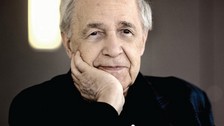
Pierre Boulez (1925–2016, France), composer, conductor, and music theorist, was one of the leading figures of post-war European music. In 1941, he moved to Lyon with the intent to study mathematics, but changed his mind and a year later began studies at Conservatoire de Paris, against the wishes of his father. Boulez studied with Olivier Messiaen, and privately took the lessons from René Leibowitz. He graduated in 1945 and, still only 21, became musical director of the Théâtre Marigny of Jean-Louis Barrault and Madeleine Renaud. By the late 1940s, Boulez began using a technique known as total serialisation. One of his earliest works to gain public notice was his Second Piano Sonata (1948), following a concert performance at Darmstadt in 1952 by Yvonne Loriod, Messiaen’s wife. His Structures Ia (1951) for piano were simultaneously the highpoint and endpoint of total serialism at Darmstadt. The absolute determinism of this work cleared the way for a more inventive approach to the principles of serialism, for example in his early masterpiece Le Marteau sans maître (1953–1955) for singer and chamber ensemble. Le Marteau goes beyond strict serialism, whilst retaining tight control over the organisation of rhythms, pitches, and tempi. During the latter half of the 1950s, he began allowing greater freedom to performers in works such as Improvisations sur Mallarmé for soprano and chamber ensemble. In his Third Piano Sonata (1957), the pianist can reorder its five movements in a variety of ways, and certain passages within the movements offer alternate paths. In 1957, Boulez embarked on Pli Selon Pli, a work in five movements for soprano and orchestra to texts by Mallarmé, making use of a more restrained open-form technique. He explicated his views in various publications, such as Penser la musique aujourd’hui (1964) and Relevés d’apprenti (1966), and was a pioneer of using electronics in music. Boulez was also one of the 20th century’s most influential conductors, particularly famous for his exemplary interpretations of 20th-century classics, by composers such as Debussy, Mahler, Bartók, Varèse, Schoenberg, Webern, Berg, and Stravinsky. Boulez was chief conductor of the BBC Symphony Orchestra from 1971 to 1975, and musical director of New York Philharmonic from 1971 to 1977; in the 1990s, he was appointed guest conductor at Chicago Symphony Orchestra and Cleveland Orchestra. Boulez founded a number of musical institutions, including the concert society Domaine musical(1954), the Ensemble InterContemporain (1957), and the Institut de Recherche et Coordination Acoustique/Musique (IRCAM) during the 1970s. He received many awards, such as prestigious Grawemeyer Award in Composition for his 40-minute chamber piece Sur Incises for three pianos, three harps, and three percussionists (2000). Health issues limited his engagements after 2012, and unfortunately, he was too ill to attend celebrations in honour of his 90th birthday. Boulez passed away at his home in Baden-Baden in January 2016.
Douze Notations (1945) for piano were written during the final phase of his private studies with Leibowitz and Messiaen. Having discovered the 12-note method in early 1945, the 20-year-old composer first tried it out unsystematically in several still unpublished pieces. Then, for the first time, he used it as the basis of an entire piece. The design of Notations can be seen as a musical homage to the number 12: it consists of 12 short pieces, each one of which is 12 bars long. Each one of these miniatures has its own distinctive character, with sharp contrasts not only between the pieces but sometimes within a single piece. The element they all have in common is a 12-note row that is employed in different ways throughout the pieces, thereby creating coherence on the level of the musical material. But Notations is not a rigidly 12-note work, for Boulez treats the technique he learned from Leibowitz with great freedom. The pieces reflect not only his creative adoption of the 12-note technique and Messiaen’s rhythmic procedures, but also his study of the music of Arnold Schoenberg, Igor Stravinsky, André Jolivet, Claude Debussy, Béla Bartók, and Anton Webern, as well as non-European music.


